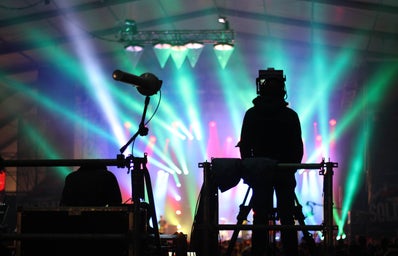Camp Flog Gnaw Carnival feels like the middle of the alternative rap universe; or maybe just an alternative universe altogether. The rainbow of clothes, booths, and stages contrasts the grey Los Angeles sky and Dodger Stadium asphalt. It is the annual music festival and carnival hosted and organized by American rapper, producer, director, designer and comedian Tyler, The Creator. Flog Gnaw is the epicenter of a colorful, funky culture that I was pleased to find out existed outside of Instagram. Headliners at the festival included Kids See Ghosts (Kanye West and Kid Cudi), A$AP Rocky, Rex Orange County, Earl Sweatshirt, The Internet, and an all-star cast of Rap, Alternative and R&B musicians.
Almost more entertaining than the music itself though, was people watching; everyone pulled up to peacock in their trendiest clothes. Double rolled beanies, Carhartt x Brain Dead overalls, checkered Vans, a blunt behind a triple pierced ear, BROCKHAMPTON merch that you couldn’t tell was merch unless you had browsed it yourself, and Golf, Golf, Golf as far as the eye could see. People chatted with strangers, rode the carnival rides, smoked, moshed, and enjoyed the music.
Odd Future group picture. Image source: Consequence of Sound
The scene at Flog Gnaw was very telling of how much of an effect Tyler, the Creator and the former collective Odd Future have had on an entire aesthetic and subculture. It surpasses just musical influence. Odd Future (fully entitled Odd Future Wolf Gang Kill Them All) was originally composed of Tyler, The Creator, Hodgy, Left Brain, The Super 3, Jasper Dolphin, and Casey Veggies. It later included Frank Ocean, Syd, Earl Sweatshirt, Mike G, and Domo Genesis. From 2007 to 2015, the Los Angeles group released five studio albums, a clothing line and an Adult Swim skit show. Most of the artists are now pursuing their own projects. Tyler has gone on to release five solo albums, create the clothing line Golf Wang, and imagine Camp Flog Gnaw into existence.
The release of his latest album, Flower Boy (2017), marked a turning point in Tyler’s career. While Cherry Bomb (2015) and the preceding albums contained many experimental tracks, Flower Boy had the most “real music” of his career. It also took on a softer aesthetic; the music was less violent and more poppy than the rest of his discography. Golf le Fleur, a line of clothes in collaboration with Converse created to accompany the album, features bright colors, floral motifs, and bold patterns. Golf le Fleur and Flower Boy are the aesthetics that informed the scene at Flog Gnaw.
His absurd sense of humor and incorrigible temper alongside his entrepreneurial success make Tyler an odd intersection of adult and child. His nonsensical humor is aligned with millennial/gen z absurd humor reflected in memes, YouTube videos, and more formal platforms such as the Eric Andre Show. Perhaps his childlike creativity and boundless imagination are what allow him to be successful; Tyler Okonoma plays by no rules except his own.
However, Okonoma has far from a clean slate. After the release of Cherry Bomb, he was banned from performing in the United Kingdom and New Zealand for inciting misogynistic sentiment. Though he has claimed it to be merely a character, lines such as “rape a pregnant bitch and tell my friends I had a threesome,” (“Tron Cat,” Goblin, 2011) are unacceptable expressions of crudeness and violence, even if it is for art’s sake. Flower Boy fully diverts the toxic masculinity of prior albums however, and even includes lyrics that suggest him being gay.
Though his net worth is only $6 million (compared to Kanye West’s $250 million or Jay-Z and Beyoncé’s combined $1.25 billion), Tyler, the Creator has asserted massive cultural impact. He has been instrumental in defining the alternative rap genre. Wearing expressive clothes, tweeting nonsensical whims, and generally exploring an unconventional identity and rise to fame have all been facets of Tyler’s phenomenon. Above all, it is an emphasis of self-expression. This is monumental both as a creative and as a black role model; “tell these black kids they can be who they are,” (“Where This Flower Blooms,” Flower Boy). As opposed to the rigid masculinity and misogyny projected in much rap (exhibit a: “Bitches Ain’t Shit” by Dr. Dre) and in Tyler’s earlier discography, Flower Boy is softer and more fluid.
Tyler performing at Camp Flog Gnaw. Image source: Rosecrans Ave.
Odd Future was the first group to combine both a unique aesthetic and the use of social media to leverage their careers. They are unconventional and riot-like. OF and subsequently Tyler’s solo career informed a subculture that challenges norms of gender, identity, and what it means to truly be a Creator.



